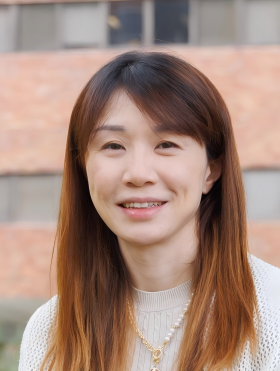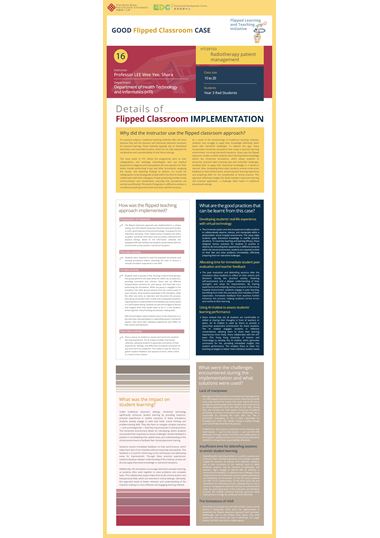
General Information
- Instructor: Prof. LEE Wee Yee, Shara
- Department: Department of Health Technology and Informatics
- Subject: HTI39103 Radiotherapy patient management
- Class Size: 15 to 20
- Students: Year 3 Rad Students
Why Use the Flipped Classroom Approach?
This issue exists in HTI, where the programme aims to train radiographers and radiologic technologists who use medical equipment to diagnose and treat patients who are injured or ill. Their duties include performing X-rays and other procedures, analysing the results, and reporting findings to doctors. It's crucial for radiographers to be strategically located within the clinic to maximise collaboration with their colleagues. Proper positioning enables timely communication and coordination, ensuring that procedures are carried out efficiently. This level of integration is difficult to achieve in a traditional teaching environment that lacks real-life scenarios.
As a result of the shortcomings of traditional teaching methods, students may struggle to apply their knowledge effectively when faced with real-world challenges. To address this gap, Shara incorporates immersive simulations that create a dynamic learning environment, mirroring real-world situations. Shara uses the flipped classroom model, in which students learn the theoretical knowledge before the immersive simulations, which allows students to encounter practical tasks involving new and unfamiliar challenges, enabling them to apply their theoretical knowledge in a hands-on manner. After completing these tasks, students receive constructive feedback on their performance, enhancing their learning experience and preparing them for the complexities of clinical practice. This approach effectively bridges the divide between classroom learning and practical application, a challenge often faced in traditional educational settings.
Implementation Steps
The flipped classroom approach was implemented in a unique setting, the HiVE (Hybrid Immersive Virtual Environment) located in U202, which features immersive technology. To prepare for the interactive workshop, Shara visited various hospitals and clinics to gather real-world information and accurately understand the physical settings. Based on the information collected, she equipped HiVE with facilities that students would interact with the environment as they would in real clinical situations.
Pre-class Activity
Students were required to read the prepared documents and working procedures before attending the class to ensure a smooth simulation experience in the HiVE.
In-class Activity
Students work in groups of five, forming a total of three groups. One group performs the tasks while the others act as observers, providing comments and criticism. Shara sets up different hospital-based scenarios for each group, and they take turns performing the simulations. While one group is engaged in the simulation, the other groups observe from the control panel. In each scenario, three students participate in the simulation, while the other two serve as observers and document the process. Each group encounters both routine and unexpected situations, requiring them to solve problems immediately, just as they would in a real hospital setting. Students are also encouraged to discuss and imagine what they would need to do in a real situation, enhancing their critical thinking and decision-making skills.
After the simulation, when students return to the classroom or in the next class, they participate in a debriefing session. During this session, they share their individual experiences and reflect on their actions and decisions.
Post-class Activity
Shara used an AI chatbot to extend and enrich the students’ learning experience. The AI chatbot enables chat-based reflection, allowing students to generate summaries of their experiences, feelings, and difficulties during the simulation at any time and from anywhere. This makes it easy for Shara to gather student feedback and respond to them, either online or in face-to-face classes.
What Impact Did This Have on Student Learning?
Students receive immediate feedback on their performance, which helps them learn from mistakes without impacting real patients. This feedback is crucial for reinforcing correct techniques and addressing areas for improvement. Through these practical experiences, students develop a deeper understanding of the material, as they can directly apply theoretical knowledge to real-world situations.
Additionally, the simulations encourage teamwork and peer learning, as students often work together to solve problems and complete tasks. This collaborative aspect helps them build communication and interpersonal skills, which are essential in clinical settings. Ultimately, this approach leads to better retention and understanding of the material, making it a more effective and engaging learning method.
What Are the Good Practices That Can Be Learnt from This Case?
The immersive system and clinical equipment enable students to collaboratively observe, interact, and manipulate within a photorealistic virtual hospital environment. This setup helps students apply theoretical knowledge to real-life practical situations. To maximise teaching and learning efficacy, Shara designed various scenarios for students to practice or observe. By recounting their experiences in different scenarios within the virtual environment, students are required to think on their feet and solve problems immediately, effectively preparing them for real-world challenges.
Allocating time for immediate student peer evaluation and teacher feedback
The peer evaluation and debriefing sessions after the simulation allow students to reflect on their actions and decisions during the practical activity, fostering self-assessment and a deeper understanding of their strengths and areas for improvement. By sharing experiences and analysing various scenarios in the virtual hospital environment, students engage in peer learning, benefiting from both the successes and mistakes of their classmates. Immediate feedback from teachers further enhances this process, helping students correct errors and reinforce their learning.
Using AI chatbot to assess students’ learning performance
Shara noticed that not all students are comfortable or skilled at sharing their thoughts in front of teachers or peers. An AI chatbot is used by Shara to provide a stress-free assessment environment for these students. The AI chatbot engages students in reflective conversations, allowing them to share their learning experiences more freely. Shara collaborates with the UST team (The Hong Kong University of Science and Technology) to develop this AI chatbot, which generates summaries for her, providing immediate insights into student performance. This enables Shara to tailor her teaching strategies to better meet individual student needs.
What Were the Challenges Encountered During the Implementation and What Solutions Were Used?
Although the HiVE provides an interactive learning experience in a CAVE-based immersive environment, Shara has to handle many tasks behind the scenes. She must reserve the room, arrange the teaching date, test the facilities, and move and set up clinical equipment from the office to the HiVE. During class, she monitors the CAVE system, the group of students simulating, and those in the panel room. Additionally, she is responsible for restoring the room after use. This is particularly challenging, as she is solely responsible for managing the entire site. Ideally, having a nearby storage room would help streamline this process.
Furthermore, due to space constraints at the university, only small classes — such as this course — can use the HiVE effectively. For larger classes, the HiVE is not a viable option. In the long term, additional instructors and technical staff will be needed to manage these responsibilities effectively.
Insufficient time for debriefing sessions to enrich student learning
Debriefing after teaching activities is crucial for students as it enhances their learning experience and provides valuable insights for teachers to improve their methods. However, due to time constraints or the methods used to collect feedback, students may be reluctant to participate, and teachers might struggle to debrief with all students or summarise the feedback. To address these challenges, Shara implemented an AI chatbot that assists in gathering feedback and facilitating communication. On the one hand, students can “talk” to the chatbot freely. On the other hand, this tool streamlines the debriefing process, allowing Shara to focus more on managing the classroom and less on administrative tasks. By automating parts of the evaluation and feedback process, the chatbot enhances learning outcomes while helping Shara manage her workload more effectively.
The limitations of HiVE
Since there is currently only one HiVE at PolyU, Shara cannot reserve it frequently, which limits her opportunities to implement her flipped classroom approach each semester. Additionally, due to the limited room space, only small classes like this course can use it effectively. For larger classes, the HiVE may not be a viable option.

